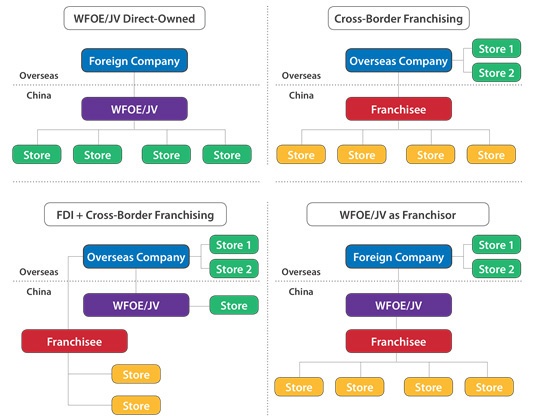FICE Franchising in China: A Flourishing Business Model
By Nicholas Hughes
Jul. 15 – Among the permitted business activities a foreign-invested commercial enterprise (FICE) can conduct (besides retailing, wholesaling and commission agency activities) is franchising. The nature and use of franchising – and the business circumstances that affect it – have changed dramatically over the past three decades.
Franchising first emerged in China in the late 1980s. Today, despite a period of disordered development in its early years due to a loose legal environment and little local knowledge of franchising, China has the largest franchise market in the world.
In 2011, with the Chinese economy booming, franchising offers a low cost rapid growth model that provides easy access to the expanding consumer market and second-tier cities. Further, franchising enables faster brand recognition, drawing in consumers that see large brand name chains as being more reliable.
Fueling the growth of franchising in China is changing customer attitudes (a desire for faster, trendier, and more convenient lifestyles), an increasing number of Chinese entrepreneurs willing to adopt the franchising model, and more Chinese entrepreneurs who want to be franchisees for foreign brands (and have the financial resources to do so).
Franchising: before
Initially, many companies with high-profile franchising operations internationally chose to avoid franchising in China. Driving reasons included the difficulty of finding good partners, lack of local management skills, local franchisees not following franchise standards (sacrificing brand image for short-term profits), lack of control over recruitment, intellectual property challenges, difficulties acquiring locations, and (primarily pre-2007 regulations) the unpredictable legal and regulatory framework.
Many of these companies entered and expanded throughout the country via direct ownership with wholly foreign-owned enterprises (WFOEs) or joint ventures (JVs), with which they opened branches in various locations.
Direct-ownership gives companies the opportunity to realize 100 percent of the profit potential from ample disposable income of the rapidly-growing middle class. It also gives the company 100 percent control over business operations. Yum! Brands Inc. (parent company of KFC and Pizza Hut) is one company that took this route – it still owns and directly manages 90 percent of its stores in China.
Franchising: today
While early entrants entered via direct-ownership, later entrants have used the franchising model to expand rapidly and close the gap with the established market-leaders.
Key examples: McDonald’s and Papa John’s.
- McDonald’s relies heavily on franchises in more mature markets such as United States, but has almost exclusively opened self-operated stores in China since entering the market in a JV two decades ago. However, the company launched a pilot franchise program in China which has been limited to three franchisees running six restaurant in the Jiangsu region. It recently moved to expand the process in April 2011, inviting new franchise applicants as it accelerates a plan to double its China network to more than 2,000 outlets by 2013.
- Papa John’s entered China via a co-operative deal which authorized its partner to manage the business, but did not permit any sub-franchising. Papa John’s subsequently opened their first franchise store in 2006 and is now one of the most prominent international companies using the franchising model. Presently, 90 percent of all Papa John’s stores in China are franchised.
- The food and beverage sector was one of the first to use franchising in China; however the majority of franchisors in this sector are domestic firms.
- In the apparel sector, franchising has been used mostly in second and third tier cities.
- In the fitness sector, franchising is a common strategy for expansion, but a number of large gym chains have started to move away from franchising to the use of WFOEs or JVs.
Franchising setup
Foreign franchisors usually franchise in China via two methods:
- Cross-border franchising
- Establishing local legal entities to serve as franchisors.
A foreign investor can establish a direct contractual relationship, in which the foreign enterprise outside of China operates a local network of franchisees or incorporate a new business in China and then act as a sub-franchiser. Foreign enterprises which intend to operate franchises in China tend to use the following franchising models:
Cross-border franchising
Thanks to 2007 amendments in China’s franchise law, a franchise contract can be signed between a foreign franchisor (which doesn’t have a local presence in china) and a master franchisee. This method has opened up opportunities for mid-sized international franchisors that do not have the resources or do not want to set up a legal presence in China. While cross-franchising is the simplest and cheapest way to franchise in China, it can result in a loss of control and supervision over the franchise.
Foreign direct investment
Foreign franchisors also have the option of franchising through foreign direct investment by first establishing a wholly-foreign owned enterprise (WFOE) or joint venture (JV) and later expanding into franchising. Although this method requires a larger amount of capital investment than cross-border franchising alone, it allows the foreign franchisor to first set up supply chain networks and establish brand awareness before later expanding.
The local legal entity (WFOE or JV) can also serve as the franchisor to local Chinese franchisees. This method simplifies things from a legal perspective, but to serve as a franchisor the WFOE or JV is required to have operated two direct-owned stores (in any global location) for at least one year before it can have franchisees (the “2+1” rule).
This method of franchising offers the foreign company greater monitoring and control over Chinese franchisees. In this instance the franchise agreement must have a minimum term of three years, which can be shortened if the franchisee agrees. This requirement does not apply in the event of an extension or renewal.

 Portions of this article were taken from the July/August 2011 issue of China Briefing magazine titled, “Trading and Establishing Foreign-invested Commercial Enterprises in China.” This issue is essential reading for anyone looking at setting up retailing, trading or franchising operations in China. To purchase the full version, priced at US$10 for immediate PDF download, please access the Asia Briefing Bookstore.
Portions of this article were taken from the July/August 2011 issue of China Briefing magazine titled, “Trading and Establishing Foreign-invested Commercial Enterprises in China.” This issue is essential reading for anyone looking at setting up retailing, trading or franchising operations in China. To purchase the full version, priced at US$10 for immediate PDF download, please access the Asia Briefing Bookstore.
Dezan Shira & Associates is a boutique professional services firm providing foreign direct investment business advisory, tax, accounting, payroll and due diligence services for multinational clients in China. The firm specializes in assisting foreign enterprises establish legal entities in China such as FICE. For advice, please email info@dezshira.com, visit www.dezshira.com, or download the firm’s brochure here.
Related Reading
 Doing Business in China
Doing Business in China
Our 156-page definitive guide to the fastest growing economy in the world, providing a thorough and in-depth analysis of China, its history, key demographics and overviews of the major cities, provinces and autonomous regions highlighting business opportunities and infrastructure in place in each region. A comprehensive guide to investing in China is also included with information on FDI trends, business establishment procedures, economic zone information, and labor and tax considerations. Priced at US$40 (PDF)
 Setting Up Wholly Foreign Owned Enterprises in China (Third Edition)
Setting Up Wholly Foreign Owned Enterprises in China (Third Edition)
This guide provides a practical overview for any business-minded individual to understand the rules, regulations and management issues regarding establishing and running a WFOE in China.
- Previous Article China and UK Sign New Tax Agreement
- Next Article Articles of Association for a China WFOE



























